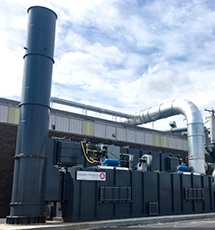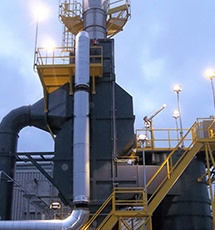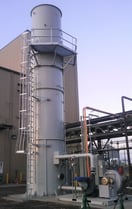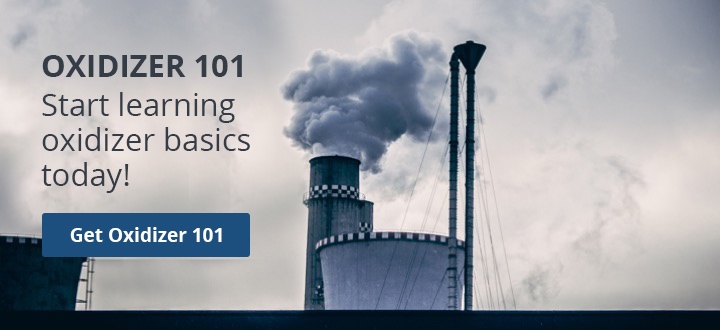It is the largest industrial source of emissions of volatile organic compounds (VOCs), a group of chemicals that contribute to the formation of ground-level ozone (smog). It also is a significant source of emissions of methane (CH4), a potent greenhouse gas.
Applications Include:
- Natural Gas Midstream Facilities
- Natural Gas Fractionation Plants
- TEG (Glycol) Dehydration
- (MEA) Desulfurization / Sweetening or Amine Tail Gas Treatment
- Natural Gas Liquids (NGL) Facilities
- Natural Gas Liquid Fractionation
- Liquefied Natural Gas (LNG)
- Refinery Wastewater Treatment
- Tank Venting VOC control
Midstream Gas Processing
 Midstream Gas processing plants are complicated production facilities which process large quantities of natural gas and hydrocarbons.
Midstream Gas processing plants are complicated production facilities which process large quantities of natural gas and hydrocarbons.
The process involves cleaning natural gas of harmful impurities and water. When natural gas is extracted from the ground, it contains high amounts of CO2, water, and corrosive sulfur compounds. A typical processing operation includes glycol dehydration and amine stripping. An amine stripper is a countercurrent stripping process where natural gas is directed into the bottom of a tall tower, and an amine liquid solution is poured into the top of the tower. As the gas contacts the liquid, the CO2, water, and H2S impurities are adsorbed from that gas and held in the fluid. The natural gas is now processed and ready to be directed to the downstream users. The amine system uses a reboiler that boils off the CO2, water, other VOC’s, and H2S so the amine solution can be re-used. The vent gas from the re-boiler is the subject to EPA guidelines; 40 CFR, Part 63, Subpart HH. Under this rule, greater than 95 percent of the pollutants must be destroyed before release to the atmosphere.
The Problem
The typical off gas from an amine treatment system is rich in CO2, contains substantial amounts of water and varying concentrations of hydrogen sulfide (H2S). These three components combine to form a corrosive gas that has a tendency to condense and form a corrosive liquid. The gas also contains a variety of hydrocarbons such as; methane, ethane, propane, butane, benzene and others, all in varying concentrations. To further complicate the abatement plan, the gas contains no oxygen. Oxygen is a necessary ingredient when “oxidizing” VOC’s.
The Solution
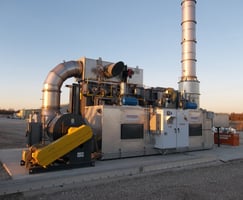 Given the complications the vent gas presents, many operators have opted to use flares as the abatement device. However, flares have several drawbacks that prevent efficient operation and must meet the flare design criteria outlined at 40 CFR, Part 63.11b.
Given the complications the vent gas presents, many operators have opted to use flares as the abatement device. However, flares have several drawbacks that prevent efficient operation and must meet the flare design criteria outlined at 40 CFR, Part 63.11b.
As a replacement technology for flares, thermal oxidation is the most common alternative. Thermal Oxidation is a process by which the vent gas is raised to 1,400 F, held in a reaction chamber where the hydrocarbons are oxidized to CO2 and water vapor. Thermal Oxidation provides very high destruction efficiency and is considered a safer method than flaring.
Thermal Oxidation can be segmented into three primary technologies for the natural gas processor:
- Regenerative Thermal Oxidation – uses ceramic media and switching valves with thermal efficiencies of up to 97%, and destruction efficiencies that can exceed 99%.
- Recuperative Thermal Oxidation – uses traditional shell and tube heat exchanger, and provides +99.9 percent VOC removal, very low CO and NOx emissions, and low natural gas cost. Emissions are reduced to well below applicable EPA standards.
- Non-recuperative Thermal Oxidation – commonly called an afterburner or combustor, this system does not employ heat recovery. These systems quickly meet EPA requirements but consume substantial amounts of fuel.
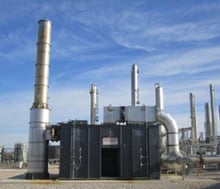
Different natural gas regions have different varieties of gas, and thus different vent gasses can be expected. All three methods are appropriate technology, but the final choice is based on the expected amount of VOC’s contained in the vent gas. If the vent gas contains low amounts of VOC ( less than 10 percent of the LEL), then the Regenerative Thermal Oxidizer (RTO) is an appropriate device. However, if the vent gas contains higher LEL or upset conditions that may exceed 25 percent, then the Recuperative Thermal Oxidizer is a better choice. Certain circumstances may point to the use of the non-recuperative Thermal Oxidizer, but considering the high fuel use, these systems are employed less.
Natural Gas Liquid Fractionators
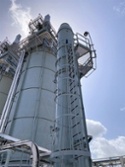 Once natural gas liquids have been removed from the natural gas stream, they must be broken down into their base components to be useful. That is, the mixed stream of different NGLs must be separated out. The process used to accomplish this task is called fractionation, or a fractionation train. A fractionator train works based on the different boiling points of the different hydrocarbons in the NGL stream. Essentially, fractionation occurs in stages consisting of the boiling off of hydrocarbons one by one. The emissions from this process can be controlled with a thermal oxidizer.
Once natural gas liquids have been removed from the natural gas stream, they must be broken down into their base components to be useful. That is, the mixed stream of different NGLs must be separated out. The process used to accomplish this task is called fractionation, or a fractionation train. A fractionator train works based on the different boiling points of the different hydrocarbons in the NGL stream. Essentially, fractionation occurs in stages consisting of the boiling off of hydrocarbons one by one. The emissions from this process can be controlled with a thermal oxidizer.
For more information, follow this link to an EBook titled Environmental solutions for Natural Gas Industries

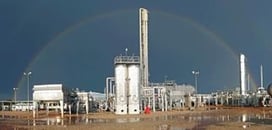
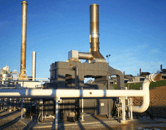

 Given the complications the vent gas presents, many operators have opted to use flares as the abatement device. However, flares have several drawbacks that prevent efficient operation and must meet the flare design criteria outlined at 40 CFR, Part 63.11b.
Given the complications the vent gas presents, many operators have opted to use flares as the abatement device. However, flares have several drawbacks that prevent efficient operation and must meet the flare design criteria outlined at 40 CFR, Part 63.11b.


